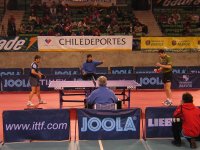I read somewhere that Liu GuoLiang stated in some interview after 2004 that the pip density reduction regulation of 2004 had a negative effect on him
I have trouble understanding this because as a I see it, ITTF passed this regulation not to limit Liu GuoLiang because the reasons seem to be that the 1998 Durban Aspect Ratio Reduction Regulation & the 2000 40- ball change were not working enough to sufficiently limit the choppers & the blockers (in fact blockers were such a nuisance that ITTF also had to pass the Frictionless Pips Ban in 2008).
Let us look this some more. The maximum pip density allowed before 2004 was 50 pips per sq.cm. It was reduced to 30 pips per sq.cm to reduce any spin capability (both back & top spins) .
So how does this really effect Liu ? Because I would tend to think he was using pips on forehand not for spin for speed. So if the pip density was dropped does it not give him more speed & really help him more ? Because why else would he be using short pips ? If he wanted more top spin , he could have used just inverted ?
Also I am not even sure what the pip density of whatever Liu used before 2004 & after 2004 was . I tried to study the pip density of many of these pips rubbers after 2004 and they all seem to be 15 or below , even long pips (I many be wrong on this) .
So unless you can provide other more compelling proof, I have to conclude as stated earlier above > the target of 2004 change was choppers & frictionless blockers (before 2008) & not Liu and short pips.
But I am open-minded & willing to change my mind if I am convinced otherwise
I have trouble understanding this because as a I see it, ITTF passed this regulation not to limit Liu GuoLiang because the reasons seem to be that the 1998 Durban Aspect Ratio Reduction Regulation & the 2000 40- ball change were not working enough to sufficiently limit the choppers & the blockers (in fact blockers were such a nuisance that ITTF also had to pass the Frictionless Pips Ban in 2008).
Let us look this some more. The maximum pip density allowed before 2004 was 50 pips per sq.cm. It was reduced to 30 pips per sq.cm to reduce any spin capability (both back & top spins) .
So how does this really effect Liu ? Because I would tend to think he was using pips on forehand not for spin for speed. So if the pip density was dropped does it not give him more speed & really help him more ? Because why else would he be using short pips ? If he wanted more top spin , he could have used just inverted ?
Also I am not even sure what the pip density of whatever Liu used before 2004 & after 2004 was . I tried to study the pip density of many of these pips rubbers after 2004 and they all seem to be 15 or below , even long pips (I many be wrong on this) .
So unless you can provide other more compelling proof, I have to conclude as stated earlier above > the target of 2004 change was choppers & frictionless blockers (before 2008) & not Liu and short pips.
But I am open-minded & willing to change my mind if I am convinced otherwise
Last edited:













